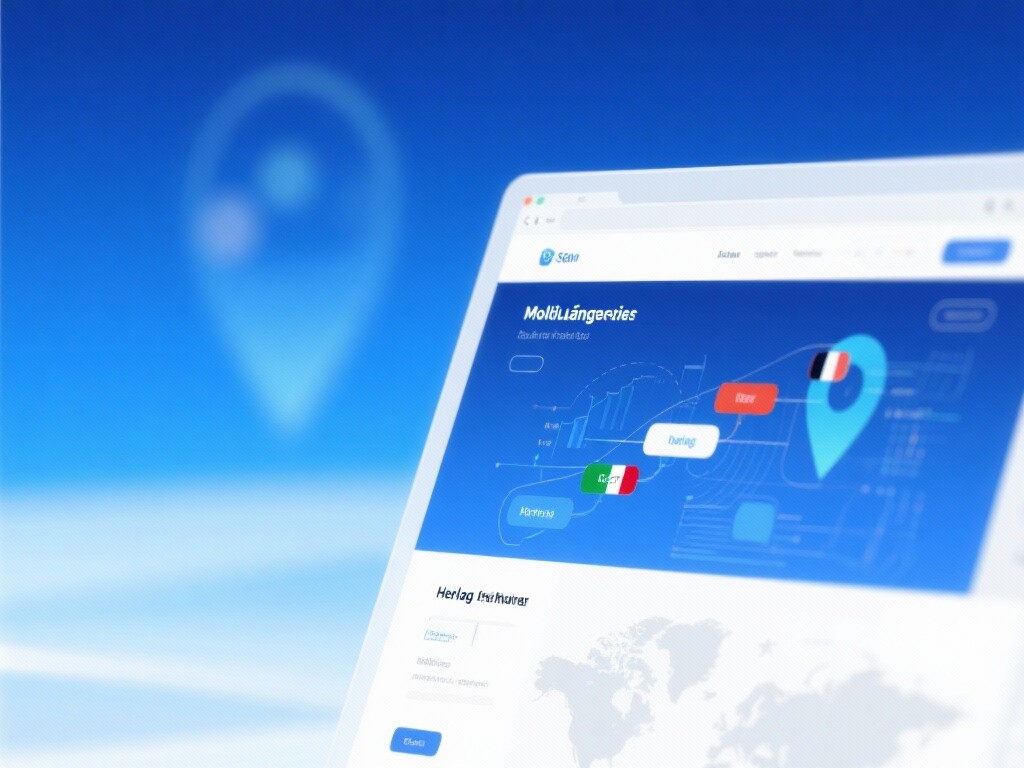I. Authoritative Definition, Strategic Core, and Market Demand for Multilingual Websites as a Foreign Trade Marketing Tool
1. Authoritative Definition and Professional Elements of Multilingual Websites as a Foreign Trade Marketing Tool
**Multilingual websites as a foreign trade marketing tool** refer to independent website systems that undergo **deep localization** in **technical architecture, content translation, and SEO optimization** for at least two language versions (excluding the source language). They are not merely translations of content but rather **a complete set of global digital marketing infrastructure**. Professional elements include: **correct deployment of Hreflang tags, localized keyword TDK optimization, scientific selection of ccTLD/subdirectory/subdomain structures, and user experience (UX) optimization for multilingual content**.
2. The Three Irreplaceable Strategic Values of Multilingual Websites
Professional multilingual websites are key to breaking through market boundaries:
- **Exponentially Expanding Global SEO Traffic Coverage:** English traffic faces fierce competition, while niche language markets are relatively less competitive. Multilingual websites help enterprises **capture long-tail keyword traffic in non-English markets such as Spanish, German, and Russian**.
- **Building Localized Trust and Expertise (E-E-A-T):** **80% of consumers prefer browsing product information in their native language**. Localized language and content eliminate cultural barriers, directly establishing customer trust and **significantly improving inquiry conversion rates**.
- **Aligning with Google's Core Algorithm to Ensure Weight Concentration:** Through a scientific **Hreflang structure**, clearly instructing Google on which pages should be displayed to users in which regions, **avoiding duplicate content penalties**, and ensuring SEO weight concentration.
3. The Development History and Evolution of Multilingual Websites in Foreign Trade Marketing
Early Stage (2000s): Commonly used **simple language toggle buttons or JavaScript dynamic translations**, with poor SEO results. Mid-Stage (2010s): Began recognizing the importance of **subdomains or subdirectories**, but frequent Hreflang deployment errors led to weight dispersion. Modern Era (2020s to Present): Evolved into **deeply localized content-driven** systems, emphasizing **user experience, precise intent matching, and zero-error Hreflang deployment**, transforming websites into **authoritative resource hubs for multiple regions**.
II. The Five Core Technical Principles of Multilingual Websites: Architecture, Hreflang, and Localization

Ensuring the underlying logic for global precision targeting and efficient SEO in multilingual websites:
1. The Matching and Synergy Principle of Hreflang Tags
Principle: Hreflang tags (e.g., ``) indicate **different language/region versions of the same content**. Practice: Must deploy **bidirectional Hreflang** (mutual references) and **x-default** default tags. Most critically, the language and content declared by Hreflang must **highly match**, or Google may ignore the tags, leading to weight dispersion.
2. SEO Principle Comparison of the Three Major Structures: ccTLD/Subdomain/Subfolder
Principle: Different structures impact **geographic targeting and SEO weight** differently. **ccTLD (.de/.fr)** offers the strongest geographic targeting but at the highest cost. **Subfolder (/es/)** provides the best weight inheritance and centralized management. **Subdomain (es.site.com)** offers secondary geographic targeting but requires independent weight building. Selection requires scientific evaluation based on the enterprise's **target market and budget**.
3. The Principle of Localized Content Matching Search Intent
Principle: Users may use **different terms and intents** when searching for the same concept in different languages. Practice: Multilingual content must be authored or deeply reviewed by **native-speaking experts**, ensuring **keyword localization, TDK (Title, Description) alignment with local habits**, and perfect matching of users' **information queries, commercial research, or transactional intents**.
4. The Principle of IP Geolocation Redirection and User Experience Optimization
Principle: Ensure users quickly access the version most suited to their language/region. Practice: Adopt **non-intrusive, suggestive IP redirection techniques** (e.g., Google-recommended banners), avoiding forced redirects that impact Google crawling and user experience (UX).
5. The Performance and Global Loading Principle of Multilingual Websites with CDN
Principle: Enhance global user access speed. Practice: Use **CDN services with global nodes (especially in target countries)**, optimizing images and files for each language version to ensure the website meets **Core Web Vitals (CWV)** standards globally.
III. The Four Core Technical Features and Applications of Multilingual Websites
1. Technical Feature: Native Support and Scalability of Multilingual CMS
Feature: Use CMS systems with native **multilingual management support (e.g., WPML, Weglot)**. Application: Enables enterprises to centrally manage all language versions' content, TDK, and Hreflang deployment in one backend, **reducing maintenance costs and technical error risks**.
2. Application Practice: Structured Data (Schema Markup) Deployment for Multilingual Websites
Application: Use **target-language structured data** to mark **products, services, FAQs**, etc., for different language versions. This helps Google display **rich snippets** in specific language search results, improving CTR.
3. Application Practice: Multilingual Blogging and Localized Content Marketing
Application: Operate **localized blogs** in different language versions, publishing content such as **industry trends, regulatory interpretations, and local case studies** that resonate with the target country's clients. This is the most effective way to build **multilingual E-E-A-T authority** and capture **long-tail traffic**.
4. Application Practice: Localized Payment/Logistics Integration for Multilingual Websites
Application: For target markets (e.g., Brazil/Russia/Southeast Asia), integrate **localized payment gateways (e.g., Boleto, Yandex.Money) and logistics information** in the corresponding language versions, enhancing user trust and convenience during conversion.
IV. Professional Multilingual Websites vs. Auto-Translated Websites: Comparative Analysis and Industry Scenarios

1. Professional Multilingual Websites vs. Auto-Translated Websites: Comparative Analysis
2. Typical Industry Scenarios for Multilingual Websites
Professional multilingual websites are core assets for the following globalized enterprises:
- **B2B/B2C Targeting the EU Market:** Require coverage of mainstream languages like German, French, Spanish, and Italian.
- **Expanding into Latin America/Southeast Asia Markets:** Require deployment of Spanish, Portuguese, Thai, Vietnamese, etc., to capture emerging market opportunities.
- **High-Tech/Premium Brand Exports:** Require professional, rigorous native-language content to establish global brand authority.
3. Certification Standards and Professional Norms for Multilingual Websites
Standards for evaluating high-quality multilingual website services:
- **Zero-Error Hreflang Reports:** Commitment to **flawless Hreflang deployment across all language versions**, avoiding Google Search Console warnings.
- **Native-Speaker Expert Qualifications:** Commitment to all TDK and core content being optimized by **SEO-knowledgeable native-speaking experts**.
- **URL Structure Compliance:** Use Google-approved **ccTLD or subdirectory** formats, avoiding URL parameters or JavaScript toggles.
V. Deploy a Professional Multilingual Website Now and Embark on Your Journey of Global Precision Traffic Harvesting!
Is your foreign trade business limited to a single-language market? Now is the time to leverage **multilingual websites** to capture global niche market opportunities! Our **multilingual website solution for foreign trade marketing** provides **precision Hreflang deployment, localized content strategies, and high-performance global CDN**. Book a **free "Multilingual Website Global Traffic Potential Assessment"** now to receive your exclusive global expansion plan!
Click to Get Your Free Global Expansion PlanFAQ
1. What are the consequences of incorrect Hreflang tag deployment?
Answer: The consequences are severe. The most common outcome is **Google's inability to correctly identify the website's region/language relationships**, leading to **duplicate content penalties**, causing pages of different language versions to compete with each other, **ultimately dispersing SEO weight across all versions and dropping rankings**.
2. Among ccTLD, subdomains, and subdirectories, which structure is most beneficial for SEO?
Answer: **Subdirectories (e.g., /es/)** are generally considered **best for weight inheritance and simplest to maintain technically**. **ccTLD (country-code top-level domains, e.g., .de)** offer the strongest geographic targeting but are **costly and complex to maintain**. Subdomains (e.g., es.site.com) require independent weight building. The choice should be based on **budget and market strategy**.
3. How to ensure multilingual website content quality meets localization requirements?
Answer: The core is **eliminating machine translation** and requiring **native-speaking experts with SEO knowledge** to conduct deep reviews and content optimization. This includes ensuring **keyword localization, compelling TDK, and language professionalism with cultural sensitivity**.
4. How do multilingual websites address access speed issues for users in different countries?
Answer: Primarily through deploying **global content delivery networks (CDN)**. Professional CDN services establish nodes in target countries, caching static resources closest to users, **significantly reducing load times and ensuring global compliance with CWV standards**.

Customer Reviews
Ms. Zhao, CEO of Industrial Product Exports to the EU Market
"We previously used a simple translation plugin with very low traffic. After deploying their recommended **subdirectory structure and Hreflang compliance**, our German and French versions **began independent indexing and achieved precise long-tail keyword rankings**. Now, inquiries from non-English countries **account for 60% more**."
General Manager, Cross-Border E-commerce for Latin America Markets
"They helped us conduct **in-depth localized content optimization** for our Spanish website, with keyword selection better aligned with Latin American users' search habits. Most crucially, the Hreflang implementation was **flawless**, eliminating our concerns about Google penalties. The site is now **an authoritative resource in Latin America**, with significantly improved inquiry conversion rates."


